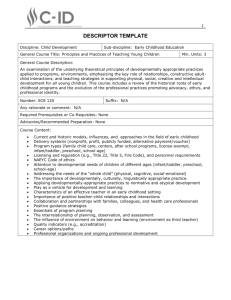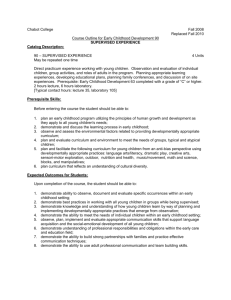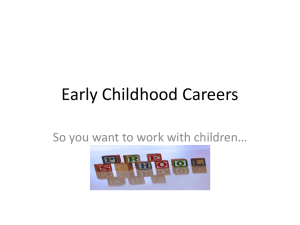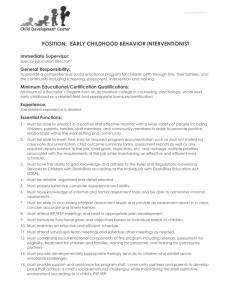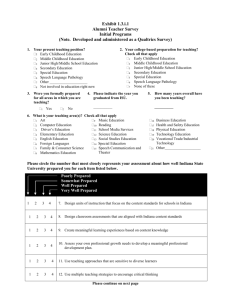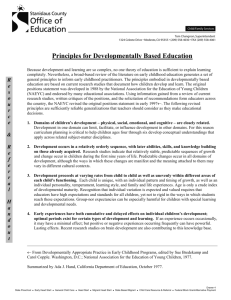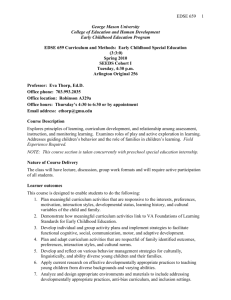Student Pre-assessment
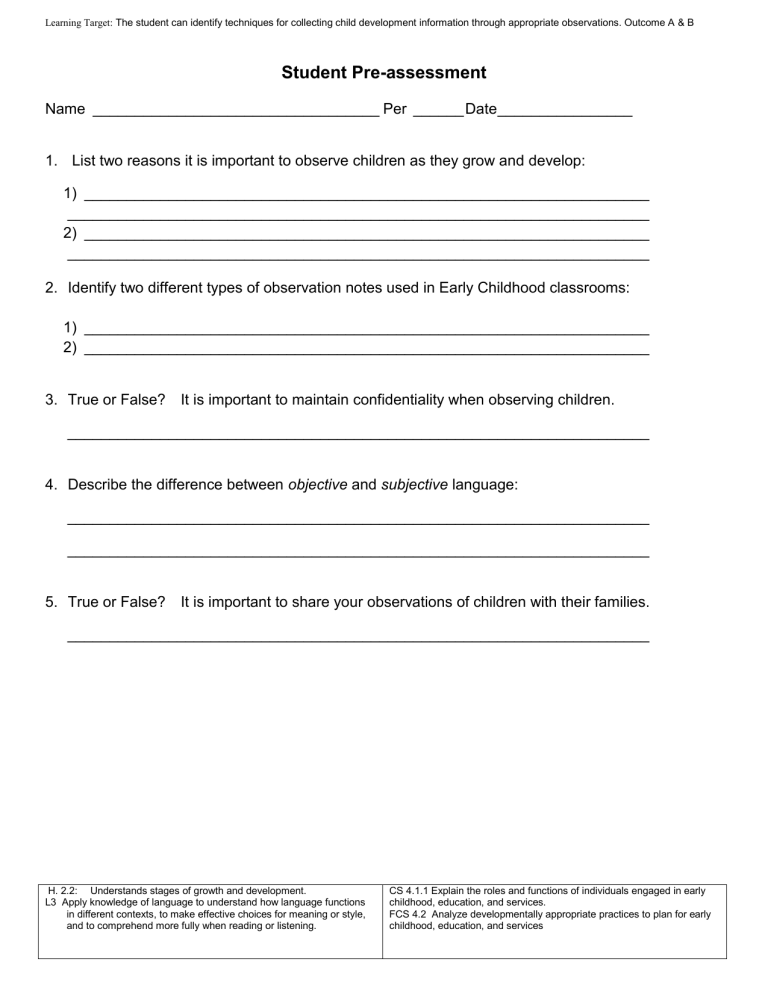
Learning Target: The student can identify techniques for collecting child development information through appropriate observations. Outcome A & B
Student Pre-assessment
Name __________________________________ Per ______ Date ________________
1. List two reasons it is important to observe children as they grow and develop:
1) ___________________________________________________________________
_____________________________________________________________________
2) ___________________________________________________________________
_____________________________________________________________________
2. Identify two different types of observation notes used in Early Childhood classrooms:
1) ___________________________________________________________________
2) ___________________________________________________________________
3. True or False? It is important to maintain confidentiality when observing children.
_____________________________________________________________________
4. Describe the difference between objective and subjective language:
_____________________________________________________________________
_____________________________________________________________________
5. True or False? It is important to share your observations of children with their families.
_____________________________________________________________________
H. 2.2: Understands stages of growth and development.
L3 Apply knowledge of language to understand how language functions in different contexts, to make effective choices for meaning or style, and to comprehend more fully when reading or listening.
CS 4.1.1 Explain the roles and functions of individuals engaged in early childhood, education, and services.
FCS 4.2 Analyze developmentally appropriate practices to plan for early childhood, education, and services
Learning Target: The student can identify techniques for collecting child development information through appropriate observations. Outcome A & B
Videos supporting this Module
Eastern Connecticut State University Center for Early Childhood Education Eclip #5, “Observing Young Children,” at: http://www.easternct.edu/cece/e-clips_observation.html
Readings- See Resources on our Web page. Required Reading
Child Care Center Licensing Guidebook (2 nd ed., DEL 2006)
Outcomes A and B: Section 2, pp 46-47 , (“Planning for Activities that Allow for Differences, Preferences and
Abilities”), Section 3, pages 73 (“Developmentally appropriate expectations”), and 101 (“Advising Parents of
Their Child’s Individual Progress”)
Outcome C : Section 8, page 223 (“Center records: Child Records and Information”)
Accessed online at: http://www.del.wa.gov/publications/licensing/docs/ChildCareCenterLicensingGuide.pdf
Introduction
Distribute Handout 1, “Why Observation?
”
Watch the video “Observing Young Children” with students: http://www.easternct.edu/cece/e-clips_observation.html.
Observation and assessment supports children’s learning and leads to meaningful curriculum. In order to have effective observation and assessment you must first understand typical child development.
As you learned in the last module on Child Development, children develop on a continuum and at their own rate. In this module we will build on that idea and learn how to celebrate child growth through observation .
Observation is a key step in the curriculum cycle
OBSERVE
What is this child doing and saying?
REFLECT
What does it mean?
How does the observation and the curriculum cycle work?
PLAN
What do I do to keep the learning going?
1. First, you must understand normal, typical child growth and development.
2. Then you need to carefully and thoughtfully observe the children in your care/classroom to see where they are on the developmental continuum.
3. By reflecting on this information you can then plan developmentally appropriate curriculum (curriculum that is appropriate for the specific abilities, interests and skills of each child).
4. Observation is not an end goal but the beginning of creating meaningful curriculum. It is the basis for decision making about how to create curriculum or alter the environment, and even informs how you interact effectively with each child.
5. As you observe, keep in mind the goals you have established for children in your care/classroom.
6. Careful observation can give you valuable data on how individual children are progressing.
H. 2.2: Understands stages of growth and development.
L3 Apply knowledge of language to understand how language functions in different contexts, to make effective choices for meaning or style, and to comprehend more fully when reading or listening.
CS 4.1.1 Explain the roles and functions of individuals engaged in early childhood, education, and services.
FCS 4.2 Analyze developmentally appropriate practices to plan for early childhood, education, and services
Learning Target: The student can identify techniques for collecting child development information through appropriate observations. Outcome A & B
Discovering Development
Name______________________________________________Per______Date____________
Work in small group of 2-3 students who also work with approximately the same age group.
Select 2-3 children you know from your site and respond to the following questions.
Refer to text- Working with Young Children Chapters 5- birth to age two, Chapter 6- two to three year olds, Chapter 7 –four and five year olds, Chapter 8- Middle Childhood )
1. Identify which child(ren) you will be referring to for this activity. What is the name (use a fictitious name), age and gender of the child(ren)?
2. List 3-5 behaviors that child exhibits as examples of their individual growth.
3. Use the Early Learning and Development guidelines book as a reference, and explain whether you believe
the child is within the typical developmental continuum. Why or why not?
Refer to text- Working with Young Children Chapters 5- birth to age two, Chapter 6- two to three year
olds, Chapter 7 –four and five year olds, Chapter 8- Middle Childhood )
4. Identify any differences in development between children of a similar age, based on the 3-5 behaviors you
listed.
5. How does noting the differences of children help us plan better for their learning and activities we chose to engage them? Use back of page if needed.
H. 2.2: Understands stages of growth and development.
L3 Apply knowledge of language to understand how language functions in different contexts, to make effective choices for meaning or style, and to comprehend more fully when reading or listening.
CS 4.1.1 Explain the roles and functions of individuals engaged in early childhood, education, and services.
FCS 4.2 Analyze developmentally appropriate practices to plan for early childhood, education, and services


